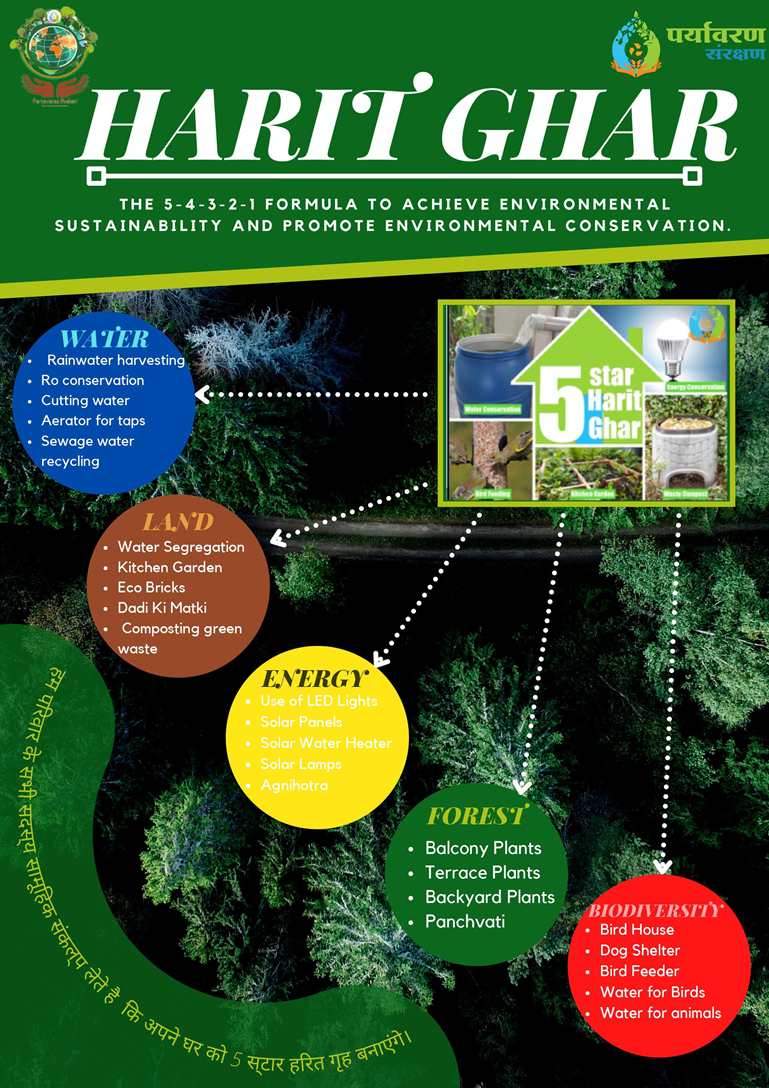HARIT GHAR (हरित घर)
“IT’S NOT ABOUT HOW BIG THE HOUSE IS, IT’S HOW HAPPY THE HOME IS”
Home is the sanctuary where happiness and peace are sought. It’s a place where one should
find comfort and joy. If happiness isn’t found at home, it’s unlikely to be found elsewhere.
Therefore, it is our collective responsibility to create a living space that fosters well-being
and sustainability. This is the driving philosophy behind the Harit Ghar initiative, launched
by Paryavaran Sanrakshan Gatividhi (PSG). This initiative aims to educate and encourage
households to adopt simple yet effective conservation techniques to make every home a ‘Harit
Ghar’ (Green Home).
Objective (उद्देश्य)
The primary objective of the Harit Ghar initiative is to transform every home into a green and
sustainable living space. This involves promoting environmental sustainability and
advocating for environmental conservation practices that can be easily integrated into daily
life. The PSG team is dedicated to making these practices accessible and understandable for
everyone, ensuring that the principles of a Harit Ghar are achievable for all households.
To make every home “Harit Ghar” to achieve Environmental sustainability and promote
Environmental Conservation.
पर्यावरणीय स्थिरता प्राप्त करने और पर्यावरण संरक्षण को बढ़ावा देने के लिए हर घर को “हरित घर”
बनाना।
To promote the importance of “Harit Ghar” and provide technical support to achieve it.
“हरित घर” के महत्व को बढ़ावा देने और इसे प्राप्त करने के लिए तकनीकी सहयोग प्रदान करना।
Focus Areas (ध्यानाकर्षण क्षेत्र): 5 संरक्षण
The Harit Ghar initiative focuses on five key areas of conservation, each critical for the
overall health of our environment.
- Water Conservation (जल संरक्षण)
Water is a precious resource, and its conservation is essential for sustaining life. Harit Ghar
emphasizes the importance of efficient water use and management practices such as rainwater
harvesting, reducing water wastage, and recycling greywater. By adopting these techniques,
households can significantly reduce their water footprint and contribute to the broader goal of
water conservation. - Forest Preservation (वन संरक्षण)
Forests play a crucial role in maintaining ecological balance. The initiative encourages
households to support forest preservation through activities such as planting trees, reducing paper usage, and promoting the use of sustainable wood products. These actions help protect forest ecosystems and the biodiversity they support. - Animal Protection (जीव संरक्षण)
Harit Ghar also highlights the importance of protecting animal life. This includes advocating
for the humane treatment of animals, supporting wildlife conservation efforts, and reducing
activities that harm animal habitats. By fostering a sense of responsibility towards animals,
the initiative aims to create a harmonious coexistence between humans and wildlife. - Energy Conservation (ऊर्जा संरक्षण)
Energy conservation is pivotal in reducing our carbon footprint. The initiative promotes the
use of energy-efficient appliances, adopting renewable energy sources like solar power, and
implementing simple practices such as turning off lights and unplugging devices when not in
use. These measures help reduce energy consumption and mitigate the impacts of climate
change. - Land Conservation & Tree conservation (भूमि संरक्षण & वृक्ष संरक्षण)
Land conservation involves protecting and sustainably managing our land resources. Harit
Ghar encourages practices such as composting, organic gardening, and reducing the use of
harmful chemicals in agriculture. These practices help maintain soil health, reduce pollution,
and enhance the productivity of the land.
Tree conservation is essential for maintaining ecological balance and combating climate
change. One effective strategy is promoting the creation of a “Green Corner” in every
household. A Green Corner is a dedicated space for planting trees, shrubs, and flowers,
fostering a miniature ecosystem at home. This not only beautifies living spaces but also
contributes to air purification, reduces carbon footprint, and supports local wildlife.
Additionally, collecting and planting seeds is a powerful yet simple way to promote tree
growth. By gathering seeds from fruits, nuts, and local flora, individuals can actively
participate in reforestation efforts. Engaging communities in seed collection drives and
providing resources for proper planting can significantly enhance urban and suburban
greenery.
Combining Green Corners and seed collection can transform neighborhoods into verdant,
vibrant environments. This grassroots approach to tree conservation can significantly impact
global environmental health, fostering a sustainable future for generations to come.
Conclusion
The Harit Ghar initiative by Paryavaran Sanrakshan Gatividhi is a significant step towards
promoting environmental sustainability at the grassroots level. By focusing on water, forest,
animal, energy, and land conservation, the initiative aims to create a culture of environmental
responsibility and sustainable living. Through education, technical support, and community engagement, Harit Ghar seeks to make every home a beacon of sustainability, proving that a
happy home is indeed a green home.
By
Vishwanath Prasad (Volunteer – Paryavaran Sanrakshan Gatividhi & Art Of Living)

